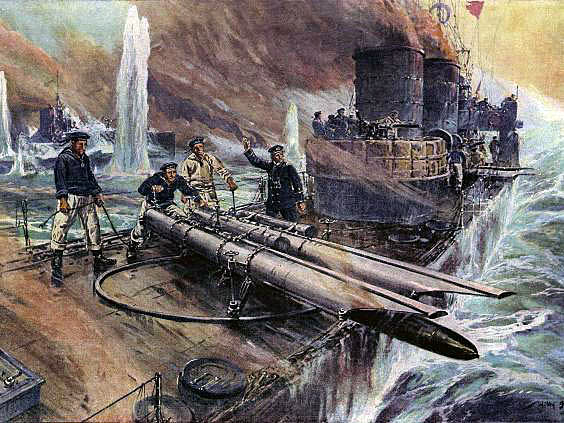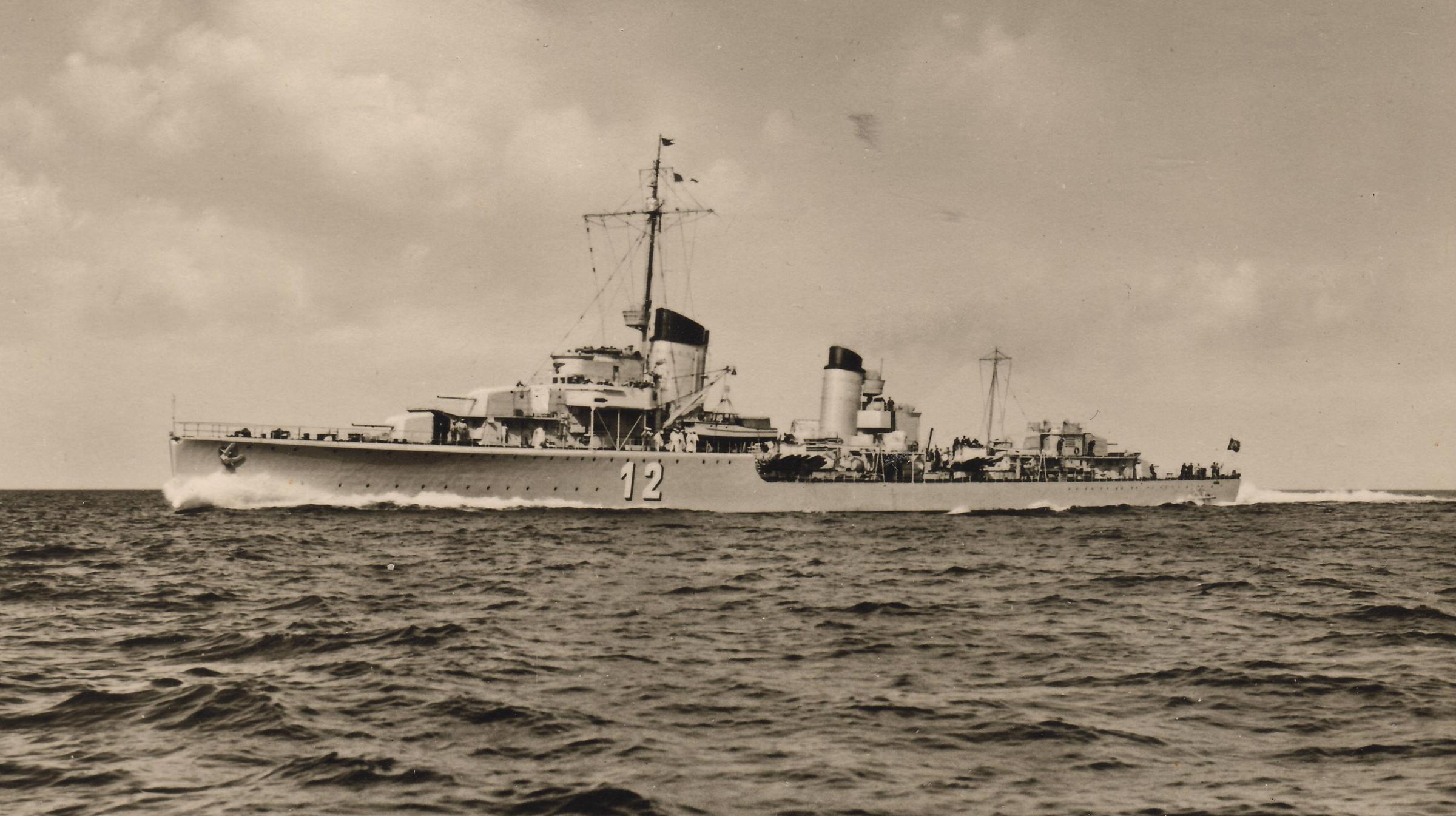The Cruel Sea:
German Destroyers, Part One
by Mike Bennighof, Ph.D.
November 2022
 While the Second Great War at Sea is a battleship war, the High Seas Fleet can’t steam into battle without its attendant screen of cruisers and destroyers. As in our own Second World War, by 1940 the destroyer has evolved into a multi-purpose warship (though still called a “boat”) vitally necessary to every navy’s inventory. And so Second Great War at Sea: The Cruel Sea, our massive alternative-history expansion set of naval war in the North Atlantic, includes 83 German destroyers. While the Second Great War at Sea is a battleship war, the High Seas Fleet can’t steam into battle without its attendant screen of cruisers and destroyers. As in our own Second World War, by 1940 the destroyer has evolved into a multi-purpose warship (though still called a “boat”) vitally necessary to every navy’s inventory. And so Second Great War at Sea: The Cruel Sea, our massive alternative-history expansion set of naval war in the North Atlantic, includes 83 German destroyers.
For the most part Imperial Germany built undersized destroyers, called “torpedo boats” even when they reached a great size. State Secretary Alfred von Tirpitz insisted on keeping them small enough to be commanded by a single officer, holding down the number of officers needed by the torpedo branch and reducing the number of promising officers diverted from battleship and cruiser postings. Actual wartime experience during the Great War swept that notion away along with many others, and the High Seas Fleet began to lay down much larger boats.
The scouting forces, represented in Berlin by Vice Admiral Georg Hebbinghaus, demanded a true destroyer, large enough to have a high freeboard that kept its armament serviceable during heavy weather, with high speed, a heavy torpedo armament and guns that out-classed the British 4-inch gun.

Yes, they were small. SMS V44 looses a torpedo during the Battle of Jutland.
The answer would be the truly gigantic Type 1916 Torpedo Boat (the vessel, despite its size, would still be a “torpedo boat”). Where the standard German torpedo boat (the Type 1913, also known as the V25/S49 classes) displaced 975 tons, the new boat would weigh in at 2,345 tons, nearly two and a half times heavier than the previous “large torpedo boat” and grow in length from 78 to 106 meters.
This vast increase in size would permit fitting of a new main armament to give the boats a decisive edge over British destroyers: four of the 150mm (5.9-inch) SK/L45 guns that equipped German light cruisers and served as secondary guns on most battleships and battle cruisers. The gun had enormously more range than the British 4-inch Mark IV (16,000 yards vs. 9,000 yards) while tossing a shell three times as large (45 kilograms (99 pounds) vs. 14 kilograms (31 pounds)). But that huge round could no longer be handled by one man, and so the main armament’s rate of fire dropped by about a half to two-thirds, from 15 rounds per minute for the 105mm to five to seven rounds per minute for the bigger gun.
The Navy ordered a dozen of the big torpedo boats in 1916, three each at the Schichau, Vulkan, Germaniawerft and Blohm & Voss yards. Like other German torpedo boats, they carried an alpha-numeric designation indicating their yard of manufacture: S113 - S115, V116 - V118, G119 - G121, and B122 - B124. Only two of the huge torpedo boats would be completed, neither in time to see service with the High Seas Fleet. All of the others were broken up while still incomplete, none of them having been launched or advanced any more than 75 percent of the way to completion.
 In our Second Great War fake history, all twelve of them were completed after the Great War, and all still serve the High Seas Fleet in 1940 though mostly in secondary roles. They’ve been modernized in the interim, with four twin 127mm (5-inch) open mounts in place of the single 150mm guns. Like other large destroyers of their era, they’ve managed to maintain good speed and have sufficient size to allow fitting of current electronics and anti-submarine equipment. In our Second Great War fake history, all twelve of them were completed after the Great War, and all still serve the High Seas Fleet in 1940 though mostly in secondary roles. They’ve been modernized in the interim, with four twin 127mm (5-inch) open mounts in place of the single 150mm guns. Like other large destroyers of their era, they’ve managed to maintain good speed and have sufficient size to allow fitting of current electronics and anti-submarine equipment.
We included five of them in The Cruel Sea in their modernized form; all 12 appeared in their original form in Great War at Sea: Jutland and Jutland 1919.
Like other navies, the High Seas Fleet began laying down new fleet destroyers in the late 1920’s. The Hornisse class is similar to those built by Britain and the United States, with four 127mm guns in single mounts, two fore and two aft, and six torpedo tubes in a pair of triple mounts on the centerline amidships.

The Type 1934 destroyer Z3 Max Schultz, inspiration for the Hornisse class.
The design is a rationalized version of the Nazi German Type 1934. She’s a smaller boat (about 1,500 tons for the Imperial destroyer, against 2,200 for the Nazi version) with one fewer gun and triple rather than quadruple torpedo mounts. Like her real-world inspiration, she had four depth-charge throwers and six racks, and is fitted to carry and lay mines. She’s a little slower than the Nazi boat (34 rather than 36 knots) and carries less fuel oil, though her range is about the same since she can burn all of her oil; the unstable Type 1934 design had to keep about a third of its fuel in the double bottom as ballast.
The Type 1934 had experimental high-pressure steam boilers, which in theory should have given the boat enormous power output. In practice this led to repeated maintenance failures, and like many other warships of the Nazi period their operational availability was quite low. Our Hornisse class carries a more conventional power plant, with lower output but far greater reliability.
 She does share with the Type 1934 a relatively short forecastle, which would have made her rather wet in heavy seas. Hornisse would still have been a better sea-boat than the top-heavy Type 1934, with somewhat less combat power in theory but probably about the same in practice. Her biggest drawback would be the lack of a dual-purpose main gun, one shared with other Imperial German ships (and their Nazi German counterparts in our reality). She does share with the Type 1934 a relatively short forecastle, which would have made her rather wet in heavy seas. Hornisse would still have been a better sea-boat than the top-heavy Type 1934, with somewhat less combat power in theory but probably about the same in practice. Her biggest drawback would be the lack of a dual-purpose main gun, one shared with other Imperial German ships (and their Nazi German counterparts in our reality).
Their primary purpose is anti-submarine warfare: while aircraft are less developed in the world of the Second Great War than in our own this is not the case with submarines. They are a serious threat, and Imperial Germany is far more dependent on overseas trade than Nazi Germany. The merchant convoys must flow between Boston and Hamburg.
The High Seas Fleet operates sixteen Hornisse-class boats, with 11 of them appearing in The Cruel Sea (the other five are in the Baltic Sea or on overseas stations). They see a great deal of action, mostly in convoy duty as the later classes of Imperial German destroyers are maximized for surface combat and accompany the battleships into action.
You can order The Cruel Sea right here, right now.
Sign up for our newsletter right here. Your info will never be sold or transferred; we'll just use it to update you on new games and new offers.
Mike Bennighof is president of Avalanche Press and holds a doctorate in history from Emory University. A Fulbright Scholar and NASA Journalist in Space finalist, he has published a great many books, games and articles on historical subjects; people are saying that some of them are actually good.
He lives in Birmingham, Alabama with his wife and three children. He will never forget his Iron Dog, Leopold. Leopold feared ocean waves.
Want to keep Daily Content free of third-party ads? You can send us some love (and cash) through this link right here.
|
